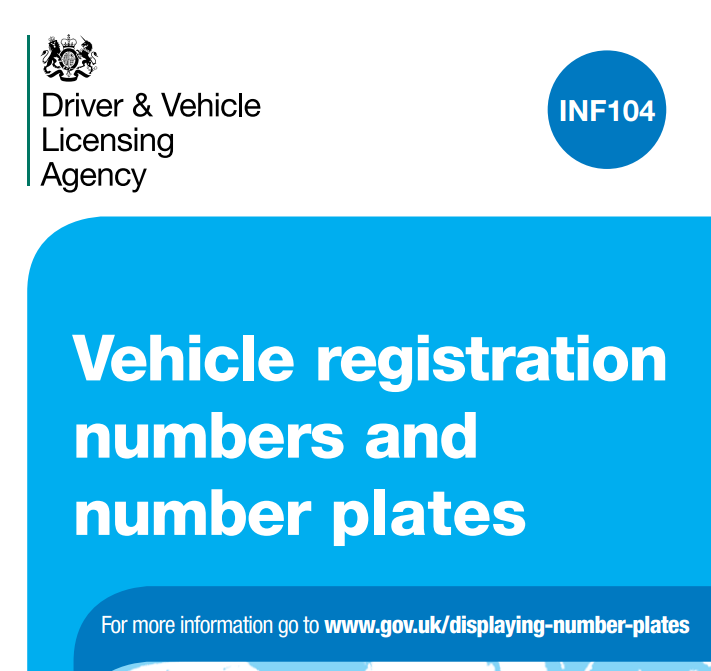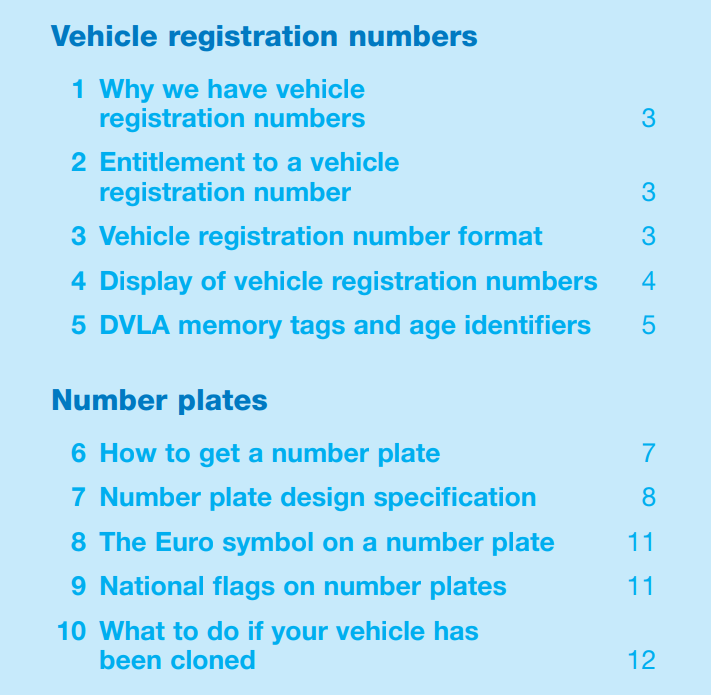C1.4 UK Number Plate¶
How to Understand UK Number Plates
Number plates in mainland China mostly use the abbreviation of a province followed by letters or numbers, such as 粤99999 in the image below, where 粤 refers to Guangdong Province.

Hong Kong (China) number plates are largely consistent with those used in the UK. If you hold a Hong Kong driving licence, you can drive in Great Britain for up to 12 months from the date of your first entry. If you wish to continue driving after this period, you must exchange it for a British licence. The Hong Kong driving licence is from a 'designated country or territory', therefore you can apply to exchange it for a full British licence within 5 years of becoming a resident in Great Britain. You are considered a resident if you live in Great Britain for at least 185 days in any calendar year (from 1st January to 31st December). Please note, once you exchange your Hong Kong licence for a British one, the Hong Kong licence becomes invalid and will be cancelled, meaning it will no longer be usable, even in Hong Kong. Furthermore, regardless of whether you had 5 years or any number of years of driving experience in Hong Kong, your driving experience will effectively start from zero in the UK.
Important: As of the latest information, exchanging a Hong Kong licence for a British one does not require retaking a practical test or passing any DVSA (Driver and Vehicle Standards Agency) test. (Note: There is a distinction between the DVSA and the DVLA in the UK; an article explaining the difference will follow). This means the exchange is direct and exempt from further testing. Of course, there is a fee of £43 for the new licence (this price is current as of October 2025).

UK number plates are divided into those issued after 1st September 2001 (new style) and those issued before 1st September 2001 (old style). This article focuses primarily on number plates issued after 1st September 2001, but will also briefly mention earlier ones.
First, let's look at a UK number plate, as shown in the image below. It is composed of letters and numbers.
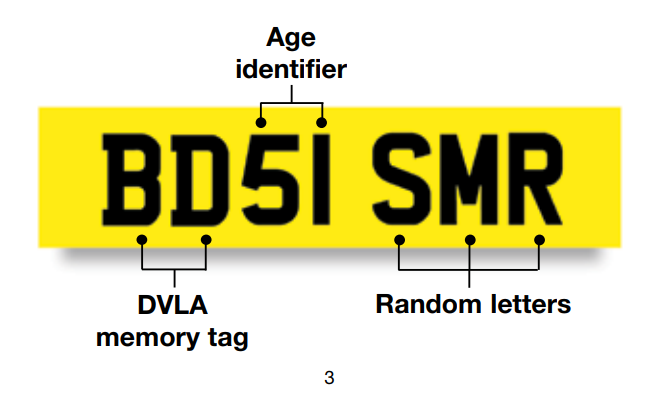
The current UK vehicle registration number format was introduced on 1st September 2001 and applies to all new vehicles. The format consists of two letters, two numbers, a space, and a further three letters. The first two letters are the DVLA memory tag, the two numbers (the age identifier) indicate the vehicle's age, and the final three letters are random.
Taking the number plate BD51 SMR in the image below as an example:
BD refers to the DVLA memory tag (or area code). For instance, BD denotes the Birmingham area.
51 refers to the age identifier. The number 51 indicates the vehicle was registered between September 2001 and February 2002. Age identifiers change every six months in March and September.
SMR refers to the random letters.
GB is an optional country identifier. GB stands for Great Britain. Displaying this identifier on the number plate is optional for driving within the UK. However, if you drive abroad, for example in European countries, you are required to display a GB identifier on the left side of the number plate.
Note: National flags or national identifiers are generally positioned on the far left of the number plate.
The available national flags to choose from are:
the Union Jack
St George's cross
The Scottish saltire
The Red Dragon of Wales
The available lettering options to choose from are:
Great Britain or GB
United Kingdom or UK
ENGLAND, England, ENG or Eng
SCOTLAND, Scotland, SCO or Sco
CYMRU, Cymru, CYM or Cym
WALES or Wales
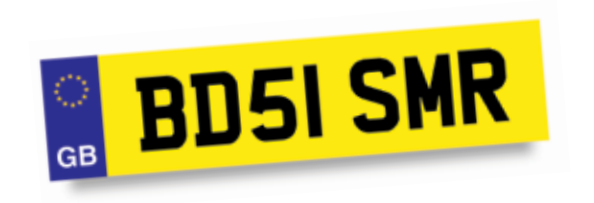
While number plates displaying these national flags and identifiers are legal for travel outside the UK, they cannot be used for identification purposes. To meet international requirements, an oval GB sticker must be displayed when travelling outside the UK (this sticker is not required when travelling within Europe if the number plate itself incorporates the Euro symbol). Furthermore, it is not permitted to display any other flags or badges on the number plate. These requirements apply only to vehicles registered in England, Scotland, and Wales. For vehicles registered in Northern Ireland, the only permissible identifier is the Euro symbol.
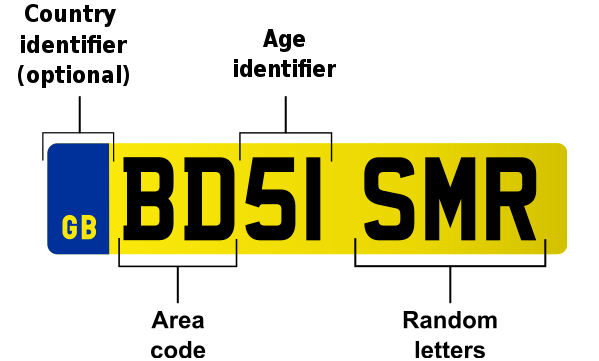

Note: From 28 September 2021, the 'UK' identifier replaced the previous 'GB' identifier. Furthermore, since 8 December 2020, zero-emission vehicles have been permitted to display a green flash on the far left of the number plate, where the national identifier is typically located. This is optional; the space can be left blank, or the green flash can be combined with the existing national flag options, as shown in the image below:

The list of DVLA memory tags (or area codes) for the UK is as follows:



Note:
(1) The letters I, Q, or Z are not used in the local memory tag identifier on UK number plates.
(2) However, existing 'Q' registrations continue to be valid and in circulation.
(3) The letter Z is used only in the random letter section of the plate.
UK Vehicle Age Identifiers



Note:
(1) This numbering format will continue until all possible combinations are exhausted.
(2) If you see a UK number plate that does not follow this format, it is likely a special registration plate, a private (personalised) plate, or a plate issued before 1st September 2001. Private plates allow individuals to purchase specific letter/number combinations. Similar to how some individuals in Hong Kong might buy plates displaying messages like "I LOVE YOU", the same is possible in the UK – virtually any combination can be purchased, provided you have sufficient funds. These plates are fully private, meaning you retain ownership of the registration even if you sell the vehicle. Prices typically range from tens of thousands to hundreds of thousands of pounds, with some even reaching millions.
Furthermore, for vehicles manufactured after 1st January 1973, UK number plates must conform to the following design standards:
1) Be made from reflective material.
2) Display a white background on the front and a yellow background on the rear.
3) Feature black characters (letters and numbers).
Regarding the standard font for number plates, new regulations introduced on 1st September 2001 mandated a standard font to improve readability. This change effectively ended the use of italicised and other hard-to-read font styles. The specifications are:
Characters must be 79mm tall.
Character width (excluding the number '1' or letter 'I') must be 50mm.
Character stroke (the thickness of the black lettering) must be 14mm.
The space between characters must be 11mm.
The space between the age identifier and the random letters must be 33mm.
Margins at the top, bottom, and sides of the plate must be at least 11mm.
The vertical space between the age identifier and the random letters must be 19mm.
The standard font is shown in the image below:
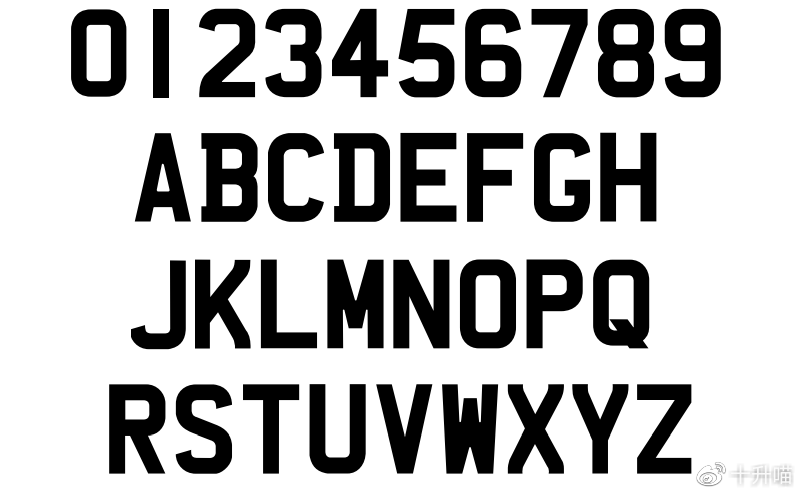
关于英国的老牌照
Regarding Older UK Number Plates
Pre-1st September 2001 number plates are less common nowadays, though they are still in use, for example on classic cars. These older plates typically followed a format of a single letter, three numbers, a space, and then three more letters (e.g., A123 ABC). The letters I, O, U, and Z were not used as the initial prefix letter.
The image below shows the prefix letters used for UK number plates between 1963 and 1983:
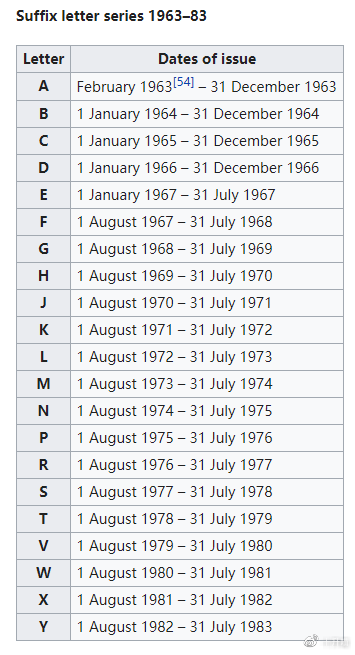
The image below shows the prefix letter series used from 1983 to 2001:
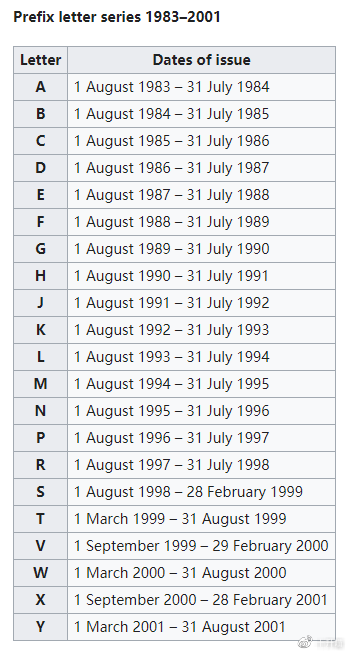
Pre-2001 Number Plate Codes
Typically, the final two letters indicated the vehicle's original area of registration. The letters I and Z were reserved for Ireland. To find the official codes more easily, or the pre-1974 council codes, look for the bolded letters in examples (e.g., ABC 123D; A123 BCD). Please note that the first two letters on post-2001 number plates do not correspond to the original registration areas indicated by the final two letters on pre-2001 plates. For example, 'AB' on a pre-2001 plate refers to Worcester, whereas 'AB' on a post-2001 plate refers to Peterborough.
The table below shows the area codes for pre-2001 number plates:

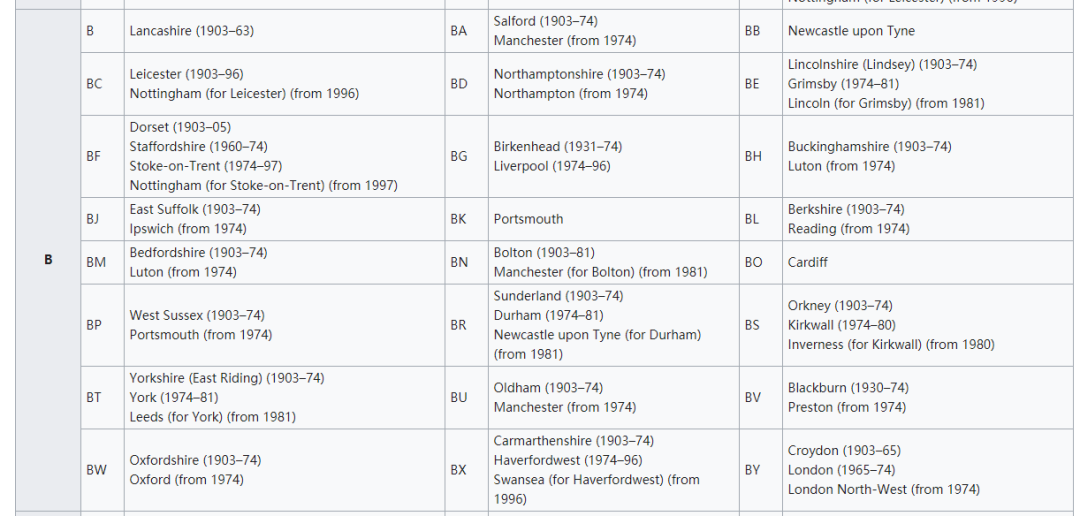
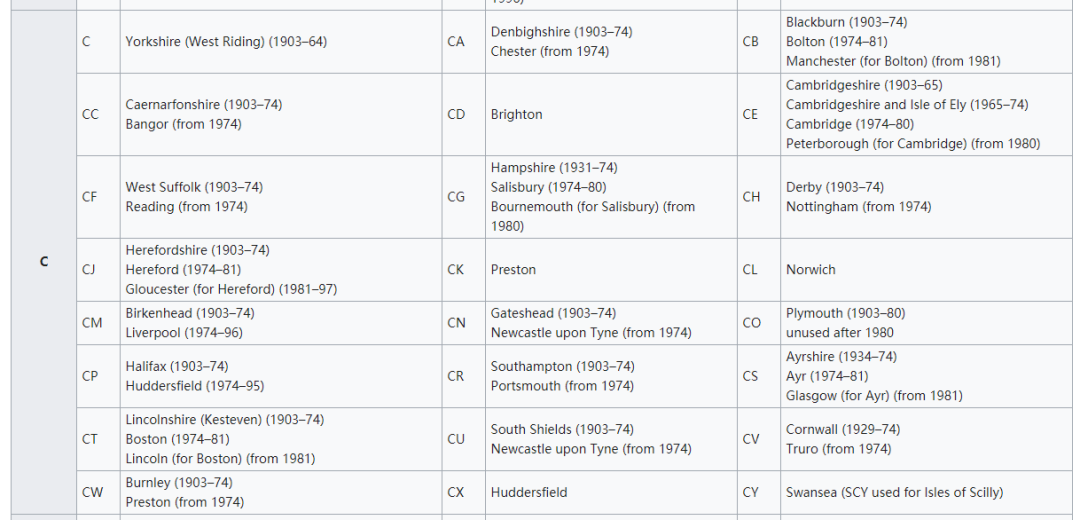
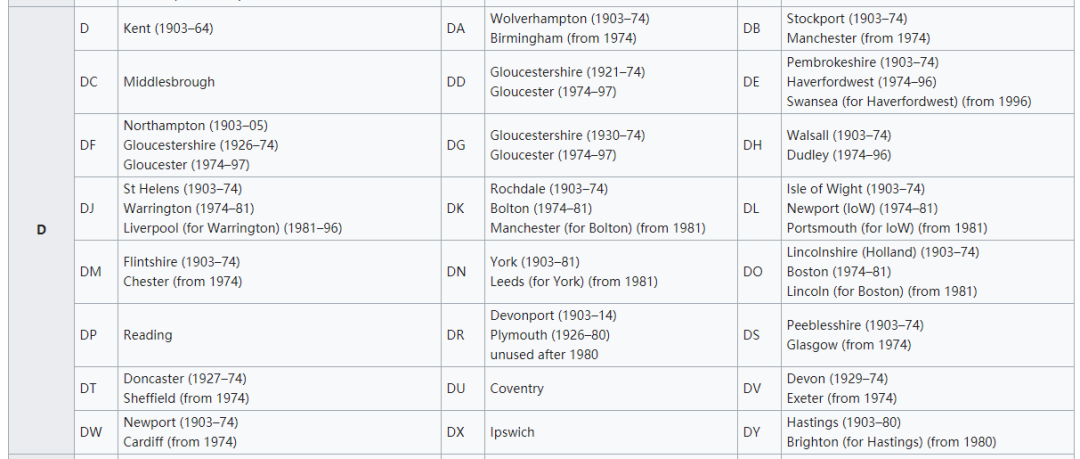

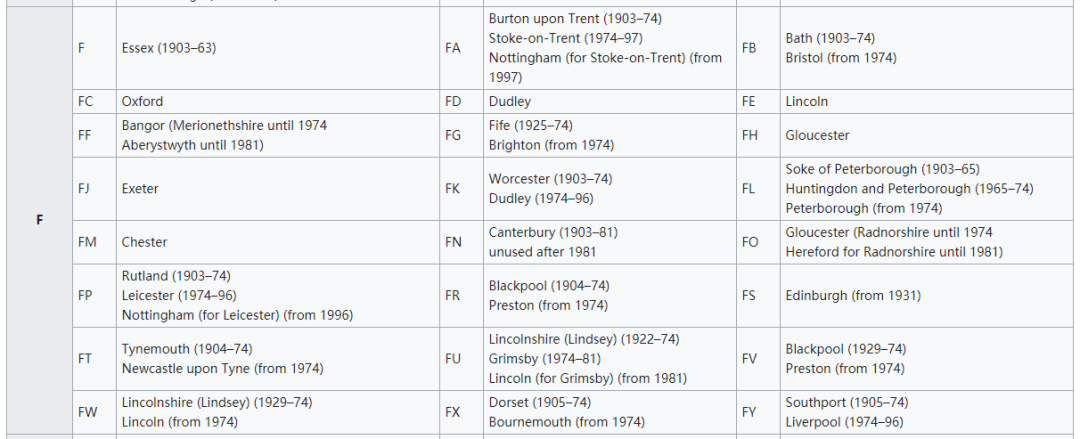
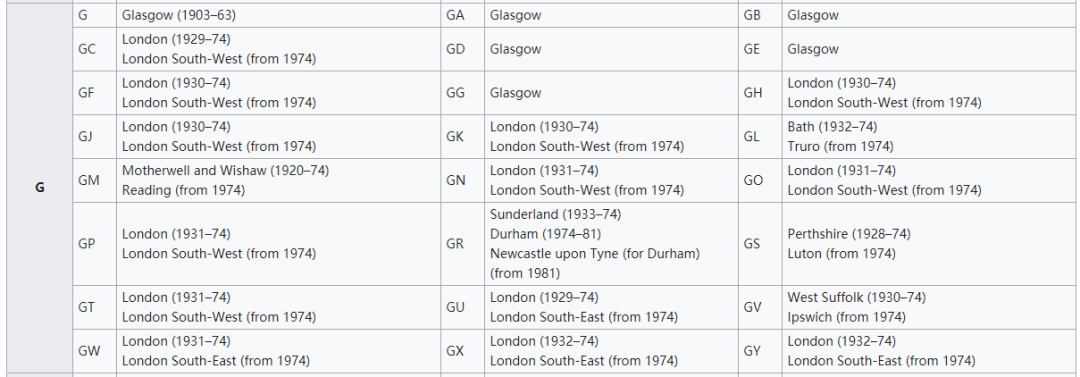

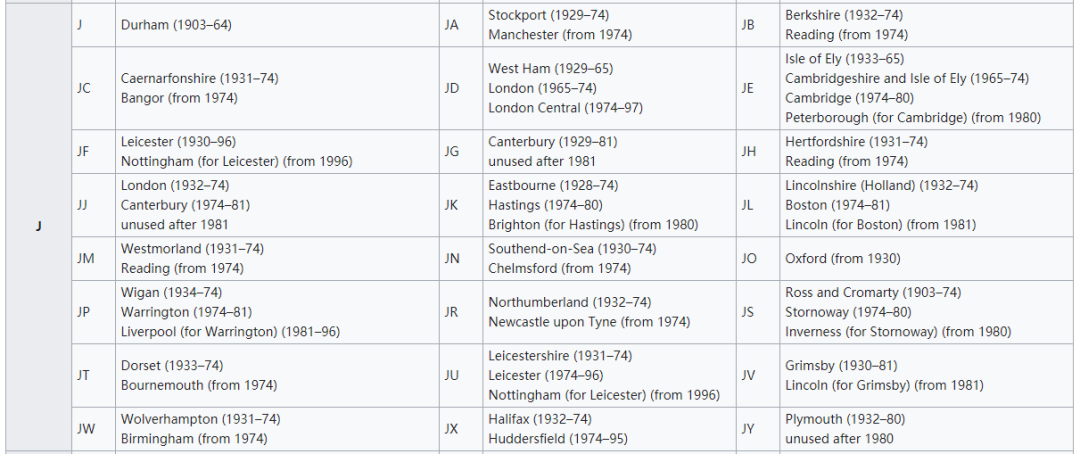

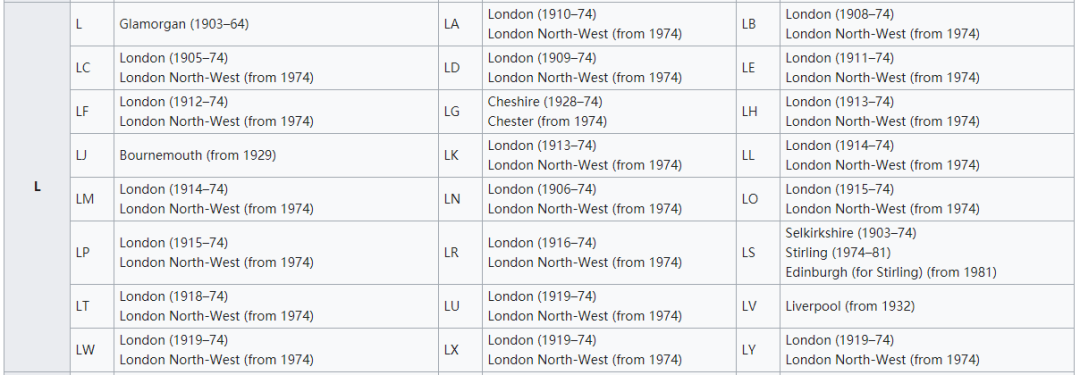




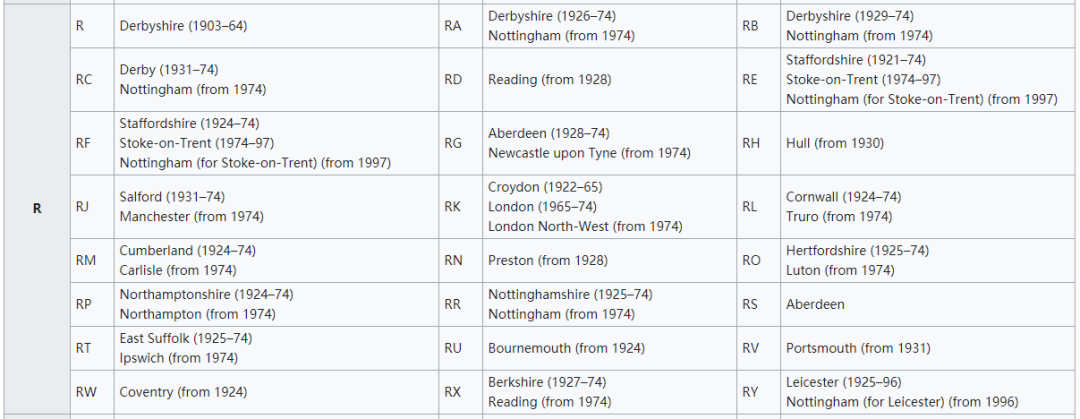
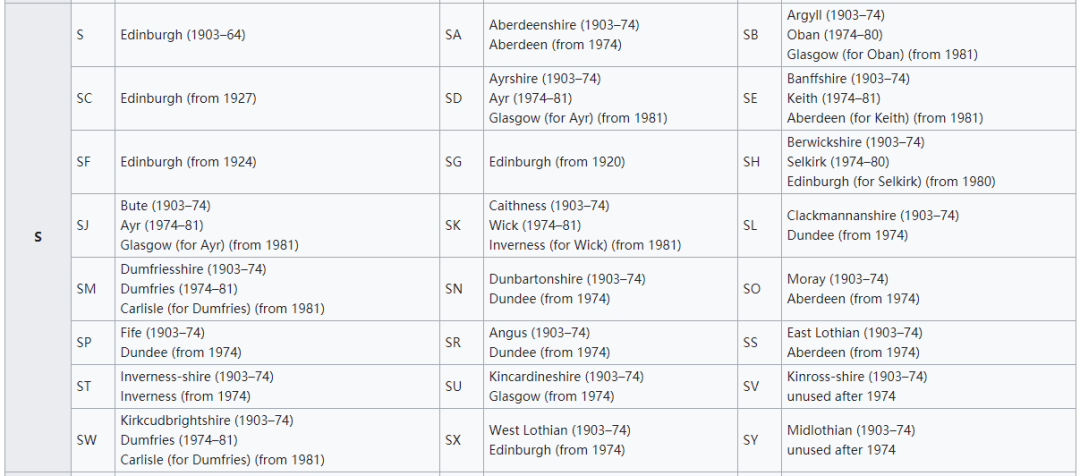
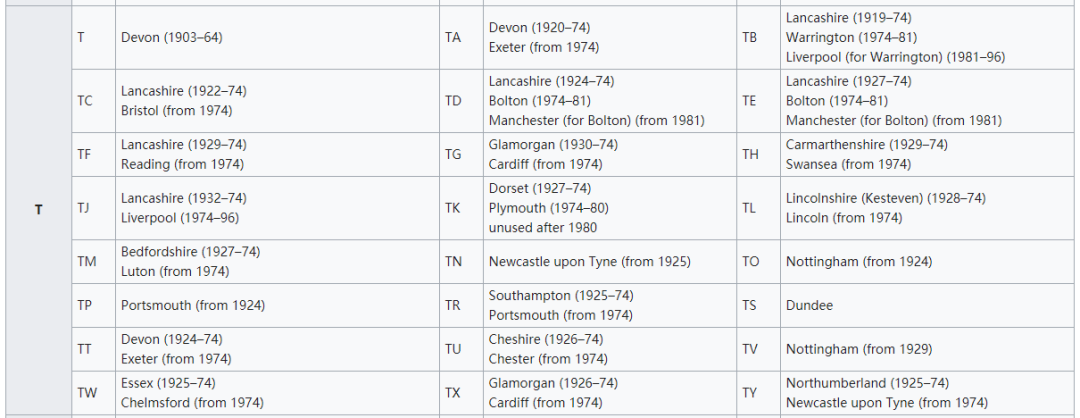

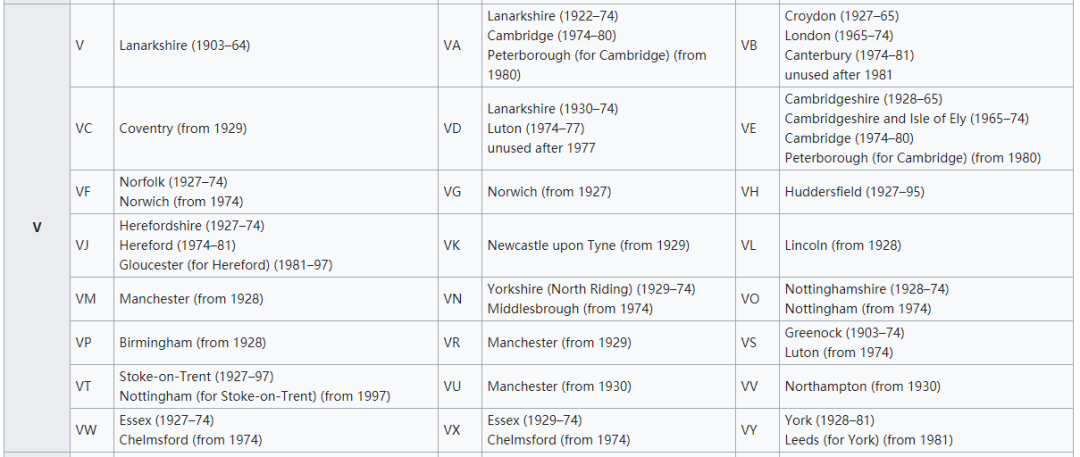


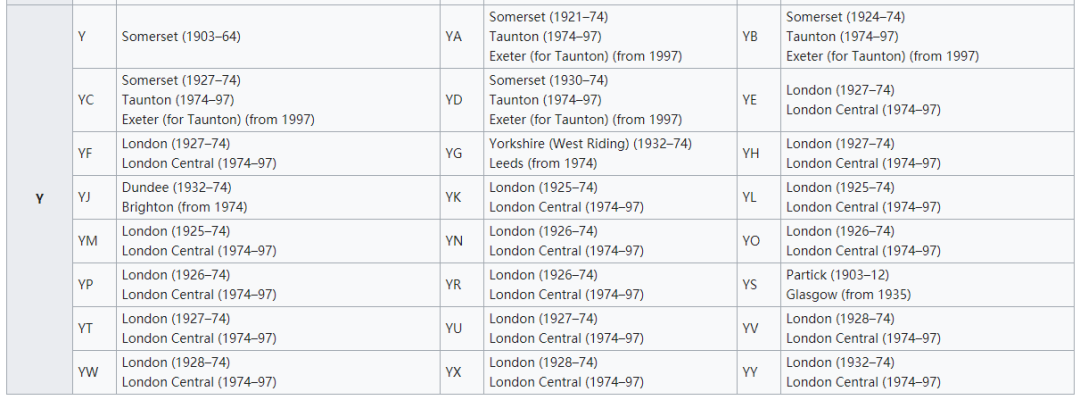
Armed Forces Vehicles
During the Second World War, British Army vehicle registration numbers followed formats like A12104, while the Royal Air Force used formats like RAF 208343. Since 1949, most UK military vehicle registration numbers have followed the format of two digits, two letters, two digits (e.g., 07 CE 08). From 1995 onwards, the format changed to two letters, two digits, two letters (e.g., JW 57 AB).
Until the mid-1980s, the middle two letters indicated the armed service, branch, or vehicle category. For example, cars from the Office of the Fleet Air Arm Support used registrations like (00 RN 04) between 1983 and 1985. The First Sea Lord's car used (00 RN 01) and the Second Sea Lord's used (00 RN 02). In 1970, HMS Albion's Land Rovers used (RN 25 97), and HMS Bulwark's minibus used (04 RN 84).
Royal Air Force vehicle registrations included formats like (55 AA 89), where the first of the two middle letters was typically 'A'. Newer style RAF plates also start with 'A', such as (RZ 00 AA) and (RU 86 AA) seen on fire engines.

Military vehicle number plates often still use the pre-1973 civilian colour scheme of black characters on a white background (front) and black on yellow (rear). They can be displayed on one, two, or three rows.
Trade Plates
Trade plates are issued to motor traders and vehicle testers, permitting them to use untaxed vehicles on public roads under certain restrictions. Since 1970, all trade plates have featured a red and white colour scheme. The registration number format consists of three numbers (preceded by a zero if necessary) followed by one, two, or three letters indicating the place of issue, using the pre-2001 format codes, as shown in the image below:
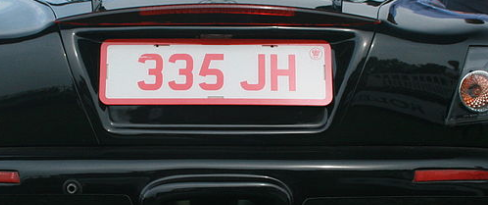
Diplomatic Vehicle Registration Plates
Since 1979, vehicles operated by foreign embassies, high commissions, consulates, and international organisations are issued special vehicle registration numbers. Eligible officials require accreditation from the Foreign and Commonwealth Office (FCO), which liaises with the specialist registrations section of the Driver and Vehicle Licensing Agency (DVLA) for issuance.
The distinctive format is three numbers, a space, the letter D or X, a space, and a further three numbers. The letter D is used primarily for vehicles operating in and around the capital, London. The letter X is used for vehicles based outside London and for international organisations, unless specified otherwise by bilateral treaty or arrangement.
The first set of three numbers identifies the country or international organisation.
The second set of three numbers follows a numbering sequence: starting at 101 for diplomats, 400 for non-diplomatic staff of international organisations, and 700 and above for consular or other non-diplomatic staff. For example, 101 D 101 was the first registration allocated to the Embassy of Afghanistan, and 900 X 400 is a registration allocated to the Commonwealth Secretariat.
A list of country codes found on UK diplomatic vehicle number plates is provided in the table below:
Number Country or Organisation
101 Afghanistan
102 Algeria
103 Argentina
104 – 108Australia
109 Austria
110 Bahamas
111 Bahrain
112 Bangladesh
113 Barbados
114 Belgium
115 Benin
116 Bolivia
117 Botswana
118 – 122Brazil
123 Bulgaria
124 Myanmar (formerly Burma)
125 Burundi
126 Cameroon
127 – 131Canada
132 Central African Republic
133 Chad
134 Chile
135 China
136 Colombia
137 Republic of the Congo
138 Costa Rica
139 Cuba
140 Cyprus
141 Czech Republic
142 Denmark
143 Dominican Republic
144 Ecuador
145 – 147Egypt
148 El Salvador
149 Ethiopia
150 Fiji
151 Finland
152 – 156France
157 Gabon
158 Gambia
159 – 163Germany
164 East Germany
165 Ghana
166 – 167Greece
168 Grenada
169 Guinea
170 Guyana
171 Haiti
172 Honduras
173 Hungary
174 Iceland
175 – 179India
180 Indonesia
181 – 182Iran
183 – 184Iraq
185 Ireland
186 – 187Israel
188 – 190Italy
191 Ivory Coast
192 Jamaica
193 Japan
194 – 195Jordan
196 Kenya
197 South Korea
198 Kuwait
199 Laos
200 Lebanon
201 Lesotho
202 Liberia
203 Libya
204 Luxembourg
205 Malawi
206 Malaysia
207 Mali
208 Malta
209 Mauritania
210 Mauritius
211 Mexico
212 Mongolia
213 Morocco
214 Nepal
215 – 217Netherlands
218 – 219New Zealand
220 Nicaragua
221 Niger
222 – 224Nigeria
225 Norway
226 Oman
227 – 228Pakistan
229 Panama
230 Papua New Guinea
231 Paraguay
232 Peru
233 Philippines
234 Poland
235 Portugal
236 Qatar
237 Romania
238 Rwanda
239 – 240Saudi Arabia
241 Senegal
242 Seychelles
243 Sierra Leone
244 Singapore
245 Somalia
246 – 247South Africa
248 – 252Russia (originally Soviet Union)
253 – 255Spain
256 Sri Lanka
257 Sudan
258 Eswatini
259 Sweden
260 Switzerland
261 Syria
262 Tanzania
263 Thailand
264 Togo
265 Tonga
266 Trinidad and Tobago
267 Tunisia
268 Turkey
269 United Arab Emirates
270 – 274United States
275 Uruguay
276 Venezuela
277 Vietnam
278 – 279Yemen
280 Serbia (originally Yugoslavia)
281 Democratic Republic of the Congo (formerly Zaire)
282 Zambia
283 Dominica
284 Monaco
285 Nauru
286 Saint Lucia
287 Uganda
288 Burkina Faso
289 Saint Vincent and the Grenadines
290 Zimbabwe
291 Vatican City
292 EastCaribbean
293 Belize
294 Brunei
295 Antigua and Barbuda
296 Angola
297 Guatemala
298 Mozambique
299 Namibia
300 Lithuania
301 Armenia
302 Slovenia
303 Latvia
304 Estonia
305 Croatia
306 Ukraine
307 Slovakia
308 Belarus
309 Albania
310 Azerbaijan
311 North Macedonia
312 Bosnia and Herzegovina
313 Uzbekistan
314 Eritrea
315 Kazakhstan
316 Georgia
317 Maldives
318 Turkmenistan
319 Kyrgyzstan
320 Saint Kitts and Nevis
321 Montenegro
324 San Marino
328 South Sudan
330 Kosovo
350 – 399Maybe used by any embassy for security reasons
600 – 649Maybe used by visiting royalty on official vehicles
900 CommonwealthSecretariat
901 Councilof Europe European Commission
902 Councilof Europe Council of Europe
903 EuropeanCentre for Medium-Range Weather Forecasts
904 North-EastAtlantic Fisheries Commission
905 Councilof Europe European Parliament
906 Inter-AmericanDevelopment Bank
907 International Maritime Organization
908 InternationalCocoa Organisation
909 InternationalCoffee Organisation
910 InternationalFinance Corporation
911 InternationalLabour Organization
912 InternationalSugar Organisation
913 EuropeanPolice College
914 InternationalWhaling Commission
915 InternationalWheat Council
916 NATONorth Atlantic Treaty Organisation
917 United Nations
918 Western European Union
919 World Health Organization
920 EasternCaribbean Commission
921 JointEuropean Torus
922 InternationalOil Pollution Compensation Fund
923 InternationalMaritime Satellite Organisation
924 CommonwealthFoundation
925 InternationalMaritime Organization (Permanent Representative)
926 CommonwealthTelecommunications Bureau
927 UnitedNations High Commissioner for Refugees
928 CommonwealthAgricultural Bureaux
929 InternationalLead and Zinc Corporation
930 Osloand Paris Commissions
931 JointEuropean Torus
932 NorthAtlantic Salmon Conservation Organization
933 EuropeanInvestment Bank
934 EuropeanTelecommunications Satellite Organisation
935 EuropeanSchool (Oxford)
936 AfricanDevelopment Bank
937 EuropeanBank for Reconstruction and Development
938 EuropeanBank for Reconstruction and Development
940 EuropeanBioinformatics Institute
941 EuropeanMedicines Agency
944 EuropeanBanking Authority
Vehicle registration numbers and number plates:https://www.gov.uk/government/publications/vehicle-registration-numbers-and-number-plates
